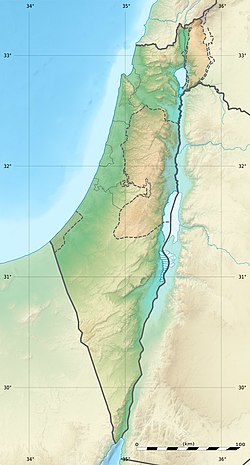Horvat Mazad
חורבת מצד (Hebrew) | |
 Ruins of a tower | |
| Alternative name | Khirbet al-Qasr (Ar.) Horvat Masad (En.) |
|---|---|
| Region | Judaean Mountains |
| Coordinates | 31°48′59″N 35°03′15″E / 31.81639°N 35.05417°E |
| History | |
| Periods |
|
| Cultures | Second Temple Judaism |
| Associated with | Jews, Hasmonean dynasty |
| Site notes | |
| Condition | In ruins |
| Public access | Yes |
Horvat Mazad (Hebrew: חורבת מצד; also known as Khirbet el-Qasr, 'the citadel' in Arabic) is located on a strategic hill rising to a height of 530 m above sea level, overlooking the road from Emmaus to Jerusalem. Excavations conducted at the site between 1977 and 1980 revealed a long settlement sequence dating back from the Late Bronze Age to the Mamluk and Ottoman periods.[1]
History[edit]
Horvat Mazad foundation is attributed to the reign of Alexander Jannaeus, when a stone complex was built covering an area of 2000 square meters. It included a tower with four rooms and a courtyard. After his death, the site was abandoned and probably repopulated during the reign of King Herod. During this period, the place became a fortified Hasmonean farm and agricultural facilities were installed including plastered water cisterns and baking ovens. The mikveh, stone tools and the lack of pig bones are evidence of the Jewish character of the place which reached its peak in the first century CE, until the outbreak of the First Jewish–Roman War.[1]
In the spring of 68 CE, soldiers of the Fifth Legion took over nearby Emmaus. According to the thickened walls at the site, Fisher assumes that the local residents were preparing for the arrival of the Roman Legion.[1] He speculates that at this point the site was abandoned in light of the Fifth Legion's ascension towards Jerusalem. After the site was destroyed, the site was not inhabited. Ceramic and numismatic finds from the Middle Roman period were found at the site, which can probably be linked to Roman military activity there.[1]
Archeology[edit]

The archaeological finds at the site indicates it was inhabited from the Late Bronze Age to the Mamluk and Ottoman periods. The first finds are attributed to the reign of Alexander Jannaeus, as the main findings include coins,[2] a casement, carved and plastered spaces, baking ovens, fortified walls and buildings remains dating to the Hasmonean period. During this period, a mikveh was also carved. The stone tools at the site and the absence of pig bones, indicate the site was inhabited by Jews.[1][2] From the Roman period, the remains of fortified walls were discovered, fragments of a milestone dating to 162 CE, is evidence of a Roman road during the days of Marcus Aurelius,[2] as well as a coin discovered with a chariot imprint of the Legio X Fretensis.
From the Crusader period, there are few ceramic findings. This proves once again that the Crusaders preferred to reach Jerusalem by other routes and not via Emmaus. From the Mamluk period as well as from the Ottoman period, ceramic findings were found that indicate the use of the site as a road station.[2]
A dirt road marked in red leads to the ruin from the College Forest within the Neve Ilan Forest.
See also[edit]
- Horvat 'Eqed – a nearby fortified site also connected with Hasmonean history
References[edit]
- ^ a b c d e Stern, Ephraim (2008). "The New Encyclopedia of Archaeological Excavations in the Holy Land, Volume 5: Supplementary Volume. Ephraim Stern". Bulletin of the American Schools of Oriental Research. 5: 1940–1942. doi:10.1086/basor27805170. ISSN 0003-097X.
- ^ a b c d הדרך ירושלים-אמאוס לאור החפירות בחורבת מצד (in iw). 1989.
{{cite book}}: CS1 maint: unrecognized language (link)

